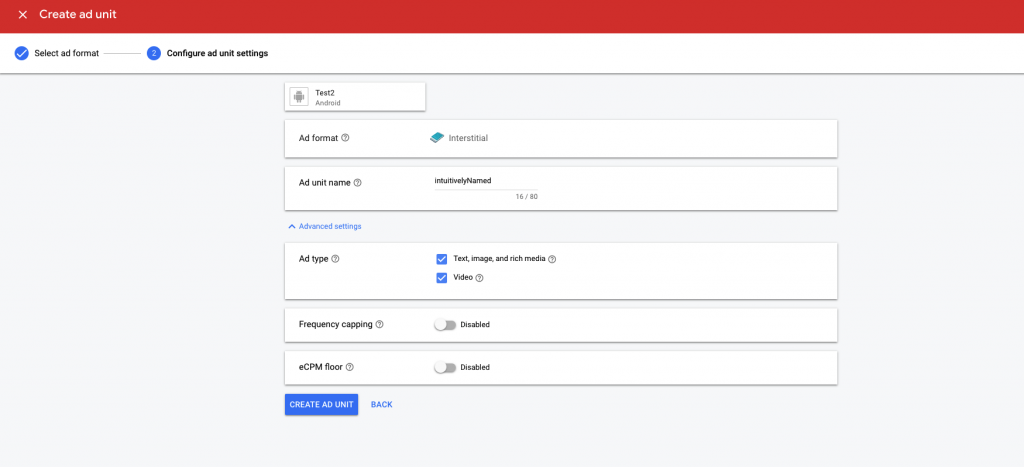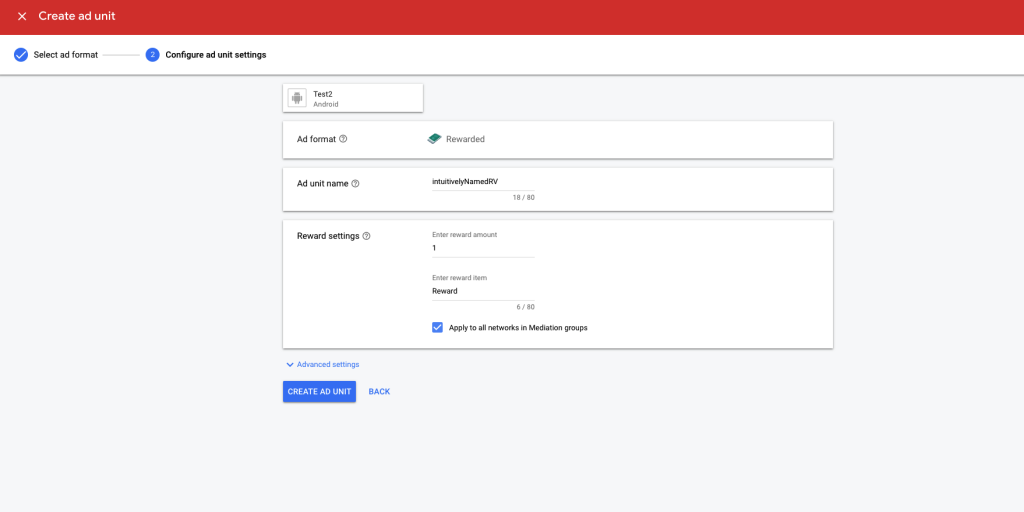Google AdMob Integration Guide
This guide instructs you step-by-step on how to set AdMob and AdMob Native as live ad networks on Unity LevelPlay Mediation.
Google Ad Manager ads are served using the AdMob SDK.
AdMob SDK supports iOS version 10+, and will server ads for users on iOS version 11+.
Step 1. Create an AdMob Account
- To access AdMob’s banner and native ad inventory through Unity LevelPlay Mediation, you need to create an account with AdMob.
- It’s recommended to adjust the time zone of your AdMob account to UTC to align with the LevelPlay platform. This will ensure accurate reporting. Learn more.
Step 2. Create an Application and Ad Zone in Admob
Next, you must add your app and set up Ad Zones in your AdMob account.
AdMob does not allow setting up more than 3 ad zones of the same Ad Type in the same setup.
e.g. no more than three Rewarded Video ads are allowed for the mediation group.
Add Your App
- Log into your AdMob account. On your dashboard, click Apps.
- A modal will appear where you can either search for your app, add your app manually or simply select an existing app to monetize.

Note: You’ll need a unique AdMob application per platform (iOS + Android), just like your LevelPlay account. - Select interstitial, rewarded video, banners, or native advanced (native ads for banners) as your ad unit format and enter the relevant details.

- Interstitial
- Rewarded Video
- Banners
- Ad Unit Name: we recommend naming the ad unit intuitively so it will be easy to recognize as the ad unit you’ll be serving AdMob Banners Unity LevelPlay Mediation
- eCPM floor – Enable and enter an eCPM value according to your country and waterfall strategy
Automatic refresh: Select the “Do not refresh” option. (Reminder – you can control the refresh rate on the mediation platform)
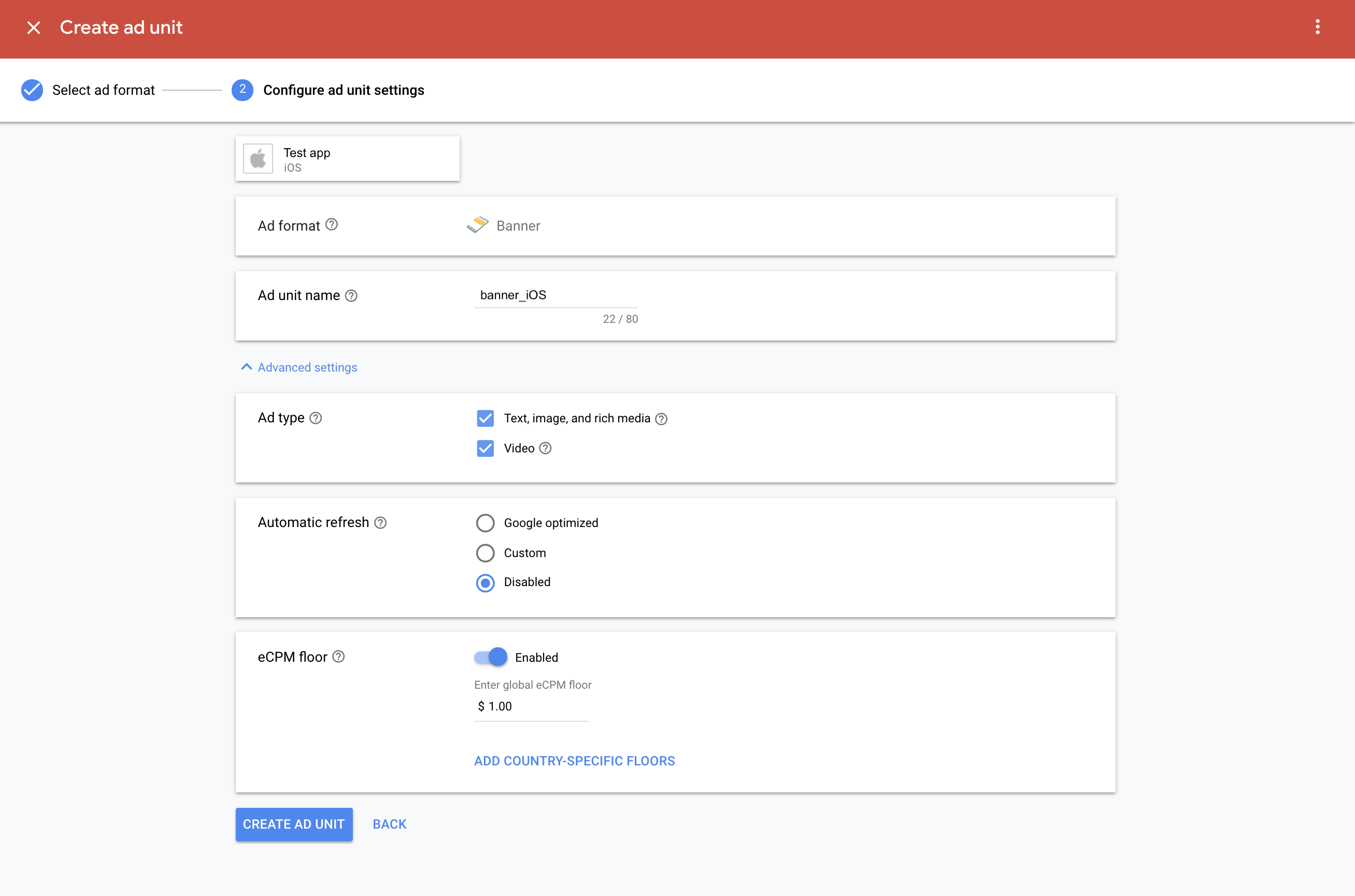
- Native Banners
Native ads for banners enables you to access native ad demand from Google AdMob. This means that you can increase banner performance by accessing both Google’s native and banner demand.
-
- Ad unit name: Type a name that you are going to easily recognize
- Advanced settings: Select both Image and Video
- eCPM floor – Enable and enter an eCPM value according to your country and waterfall strategy

Now retrieve your App ID and Ad Unit ID and save them for later use. Then, click Done.
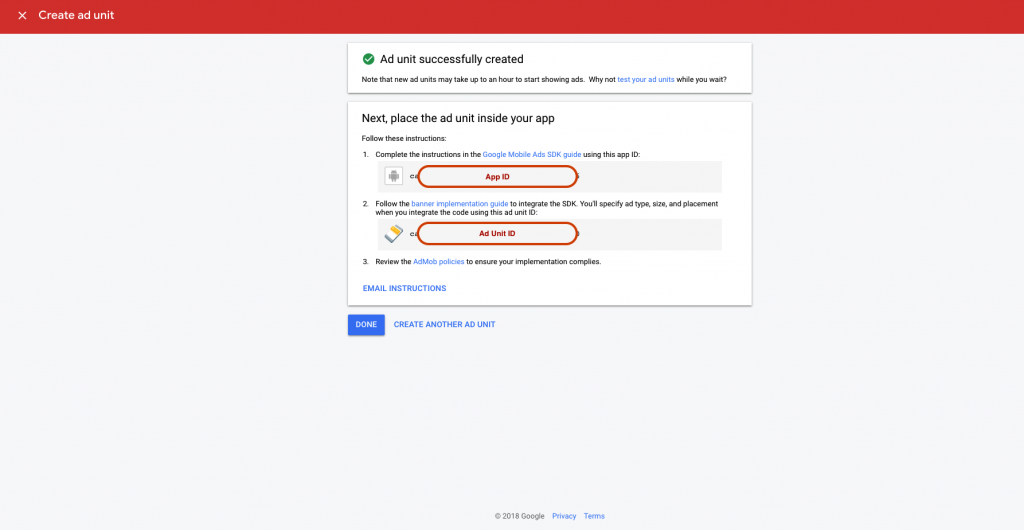
Step 3. Activate AdMob in Your LevelPlay Setup Module
Sign in to your Google account when setting up AdMob on the LevelPlay SDK Networks Setup page and the necessary parameters to run AdMob interstitials, rewarded video, banners, and native ads will automatically be retrieved.
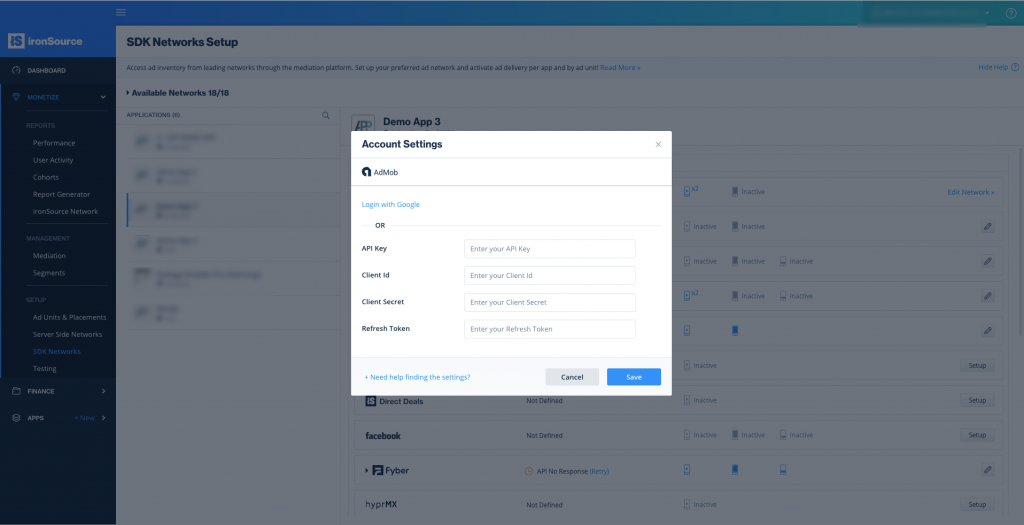
There are a few pieces of data from your AdMob account which need to be inserted into your LevelPlay Network Setup Module in order for AdMob to work correctly with the LevelPlay SDK:
| App ID |
The unique ID assigned to your app on Admob’s dashboard.
|
| Ad Unit ID |
The unique ID assigned to your app’s ad unit on Admob’s dashboard.
|
| Client ID |
This is the unique identifier that specifies the relationship between your account and the ad unit.
|
| Client Secret |
The secret key that pairs with the Client ID
|
| Refresh Token |
This is the refresh token the client application already received.
|
Once you obtain this information, you must configure AdMob’s Parameters in your LevelPlay Account. By adding the above information correctly, you will be able to take full advantage of AdMob’s ad inventory and reporting data on Unity LevelPlay Mediation.
-
-
- App ID
To retrieve your App ID, go to ‘Apps’ tab on the left side bar on Admob’s platform and click on ‘App Settings’. You will then see the application’s settings, as well as the App ID.
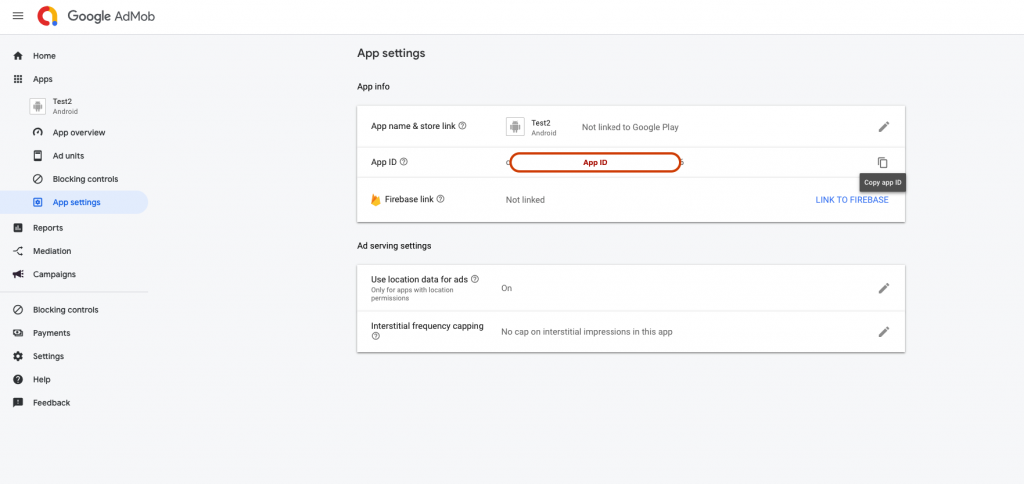
- Ad Unit ID
To retrieve your Ad Unit ID, go to ‘Apps’ tab on the left side bar on Admob’s platform and click on ‘Ad Units’. You will then see the application’s ad units, as well as the Ad Unit ID.
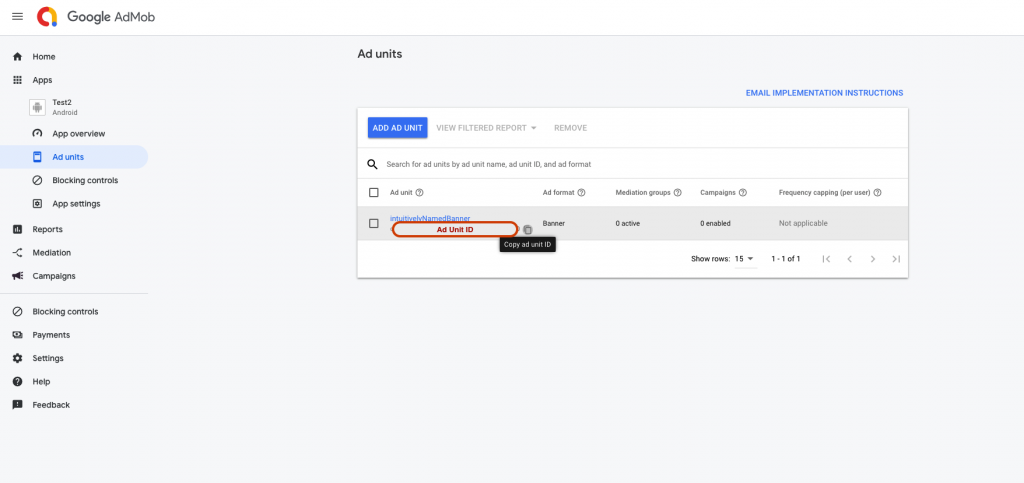
- Client ID and Client Secret
- To retrieve your Client ID & Client Secret, go to Google’s API Manager.
- Click on the API Project drop-down at the upper-left of the page, select ‘Create a project’ or select the project you already created for this app:

In the case you are creating a new project for this purpose, provide a Project name, Billing account and Location in the dialog box that appears and click ‘Create’:
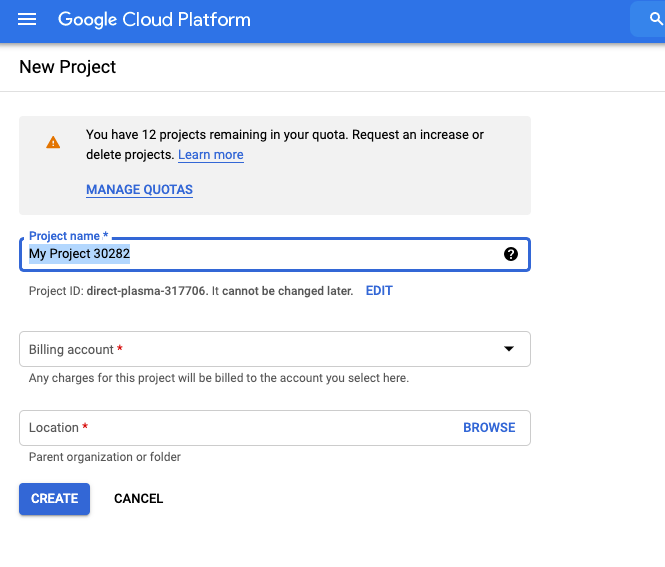
- In the left sidebar, select Credentials, then select the OAuth consent screen tab. On this page, provide a Product Name. Click Save:

- In the left sidebar, select Dashboard, and go to ENABLE APIS AND SERVICES:

- Next, enable the AdMob API:
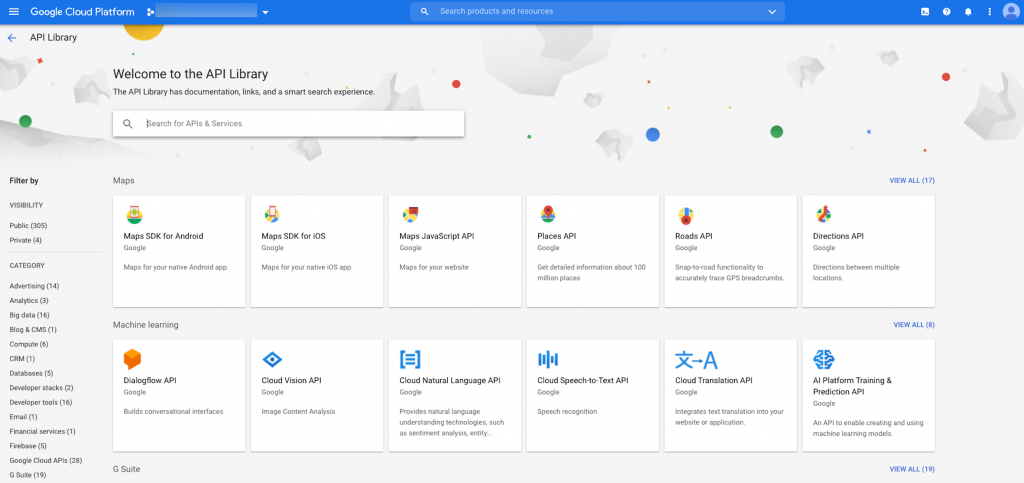
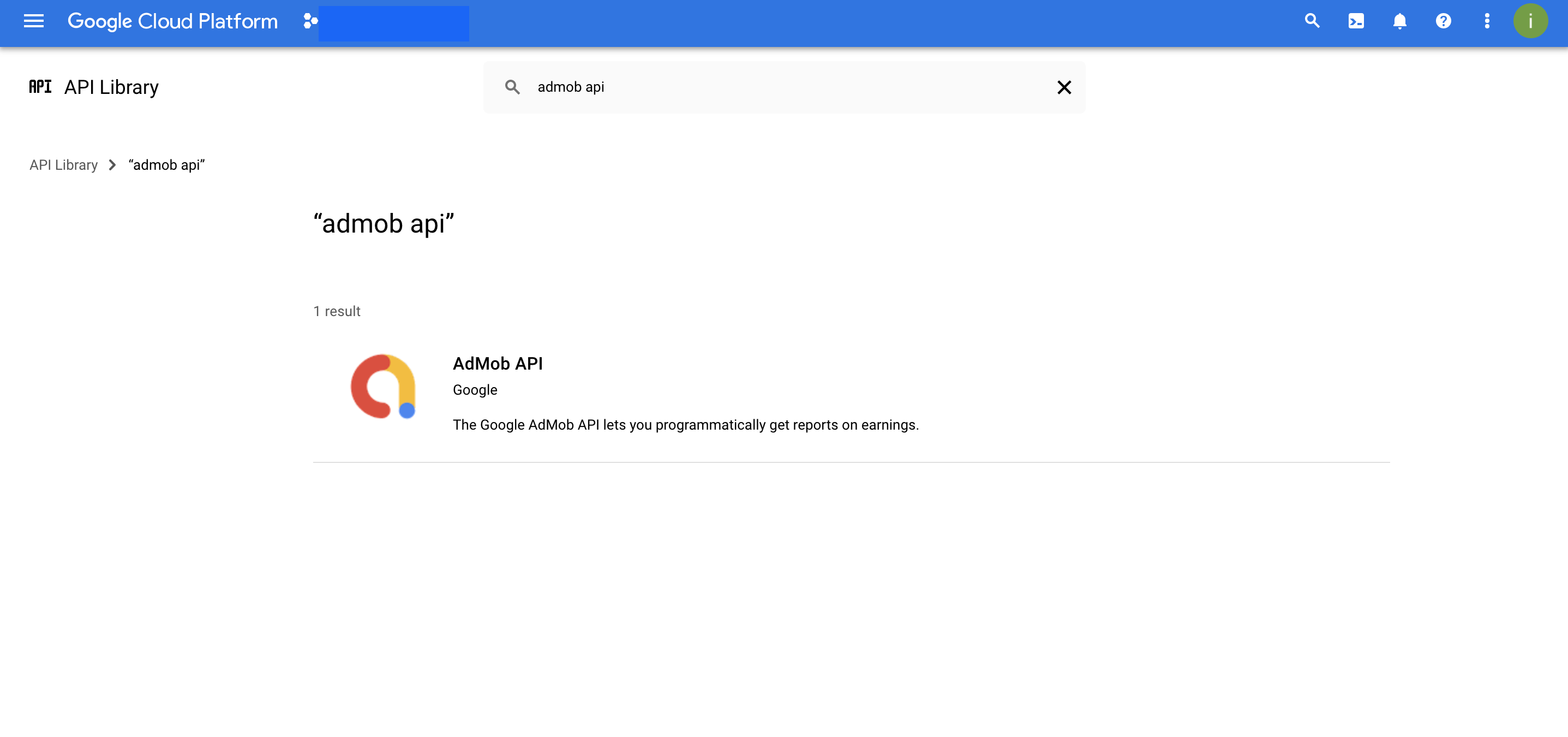
- Select the Credentials tab in the left sidebar. Click the Create Credentials drop-down and select OAuth client ID
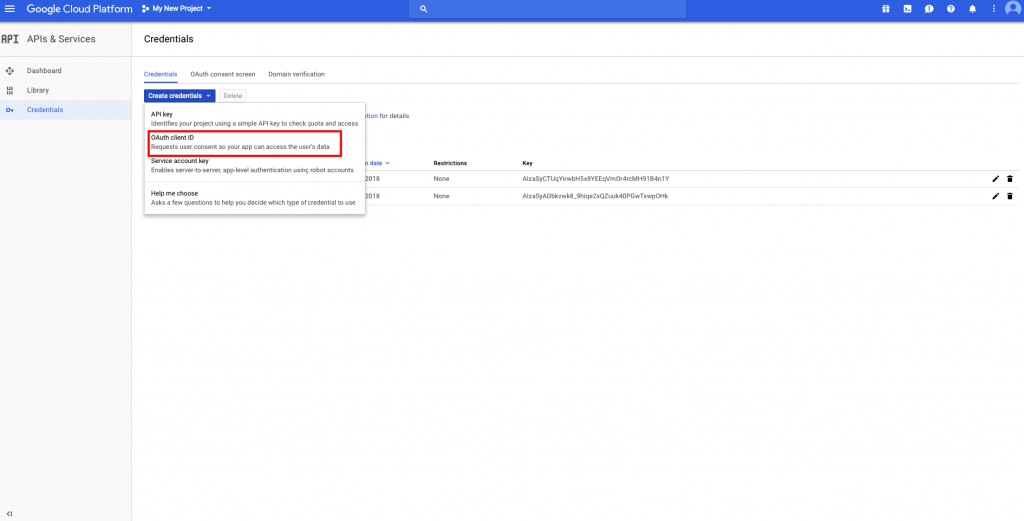
- Select Web application, and provide a name for your app. In the fields below, you must enter https://developers.google.com/oauthplayground for at least one Authorized redirect URI. For example:
- Authorized JavaScript origins:
https://YOUR_NAMESPACE (Optional) - Authorized redirect URI: https://developers.google.com/oauthplayground
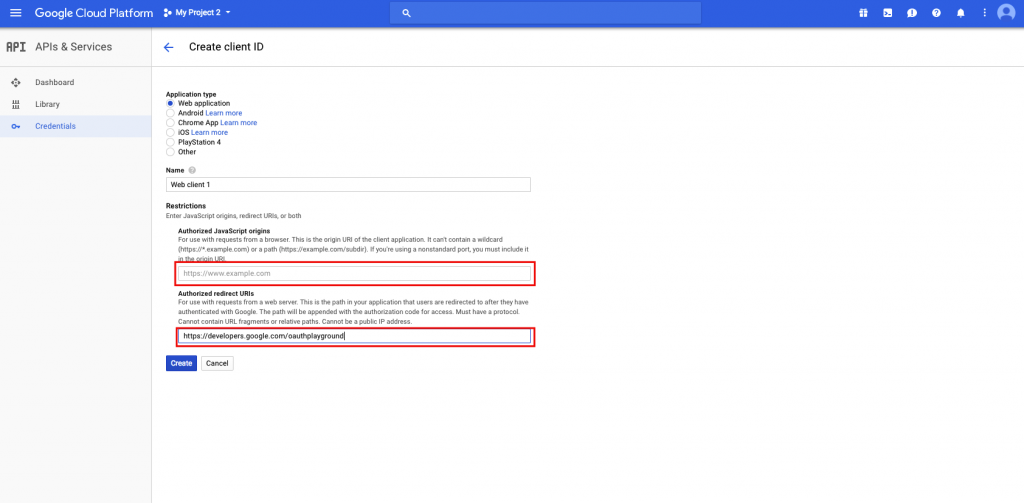
- Authorized JavaScript origins:
- Click Create, and you will be presented with your Client ID and Client Secret:
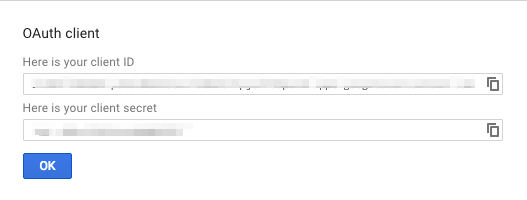
- Refresh Token
- To retrieve your Refresh Token, go to the OAuth 2.0 Playground.
- Click the settings icon in the upper right corner. Uncheck the box labeled Force approval prompt and check Use your own OAuth credentials. Input your Client ID and Client Secret

- Next, in Step 1: Select & Authorize APIS, enter ‘https://www.googleapis.com/auth/admob.report’ and click Authorize APIs:
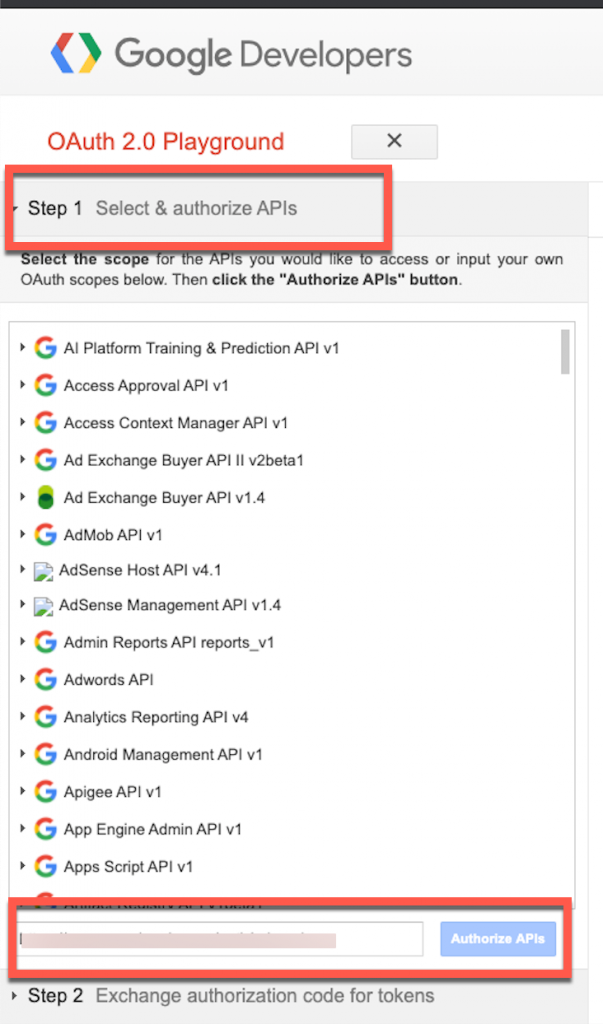
- Grant your project access to your AdMob data
- You should then receive the Authorization Code from Step 1 and will be able to click the Exchange authorization code for tokens button. Then you will get a Refresh token as well as an Access Token:

- App ID
-
Configure AdMob Parameters in your LevelPlay Account
-
-
- Once you have all of these parameters, log in to your LevelPlay account and go to ‘Monetize‘ ➣ ‘SETUP‘ ➣ ‘SDK Networks‘.
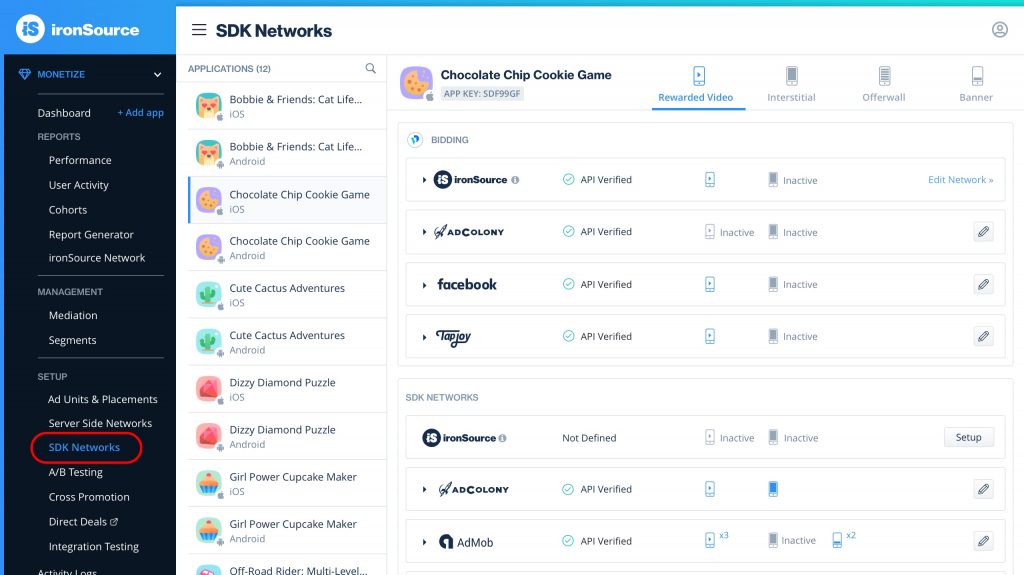
- Select Admob from the list of Manage Networks and enter the Admob Client ID, Client Secret and Refresh Token or click the Login with Google option.

Login with Google: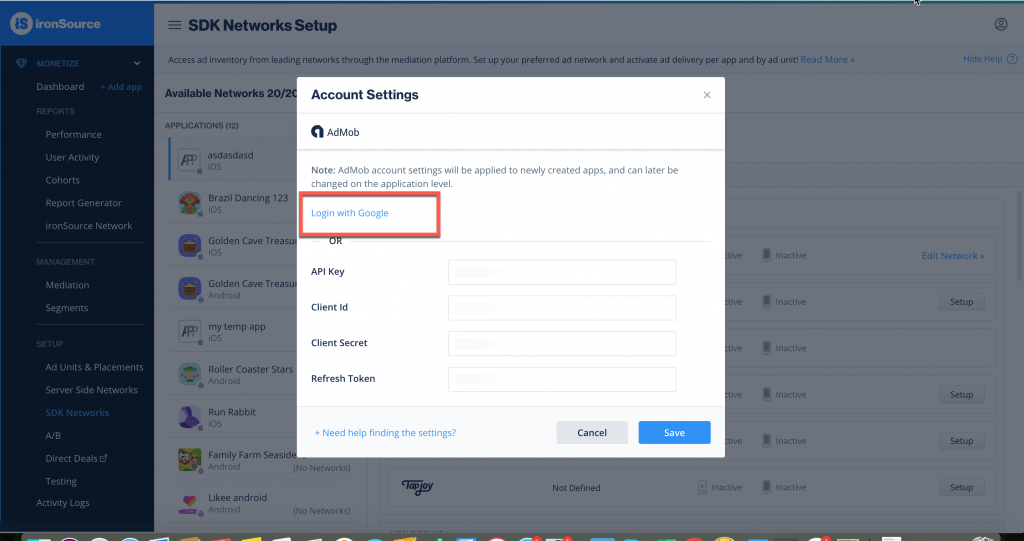
- Click Save. AdMob and AdMob Native will then be enabled in the Available Ad Networks table.

- Next, select the app on which you’d like to run Unity LevelPlay’s Mediation with AdMob.
- Select Admob from the Setup list of Ad Networks and click on the tool Define icon. Then insert the App ID and Ad Unit ID under Interstitial, Rewarded Video or Banner Settings.
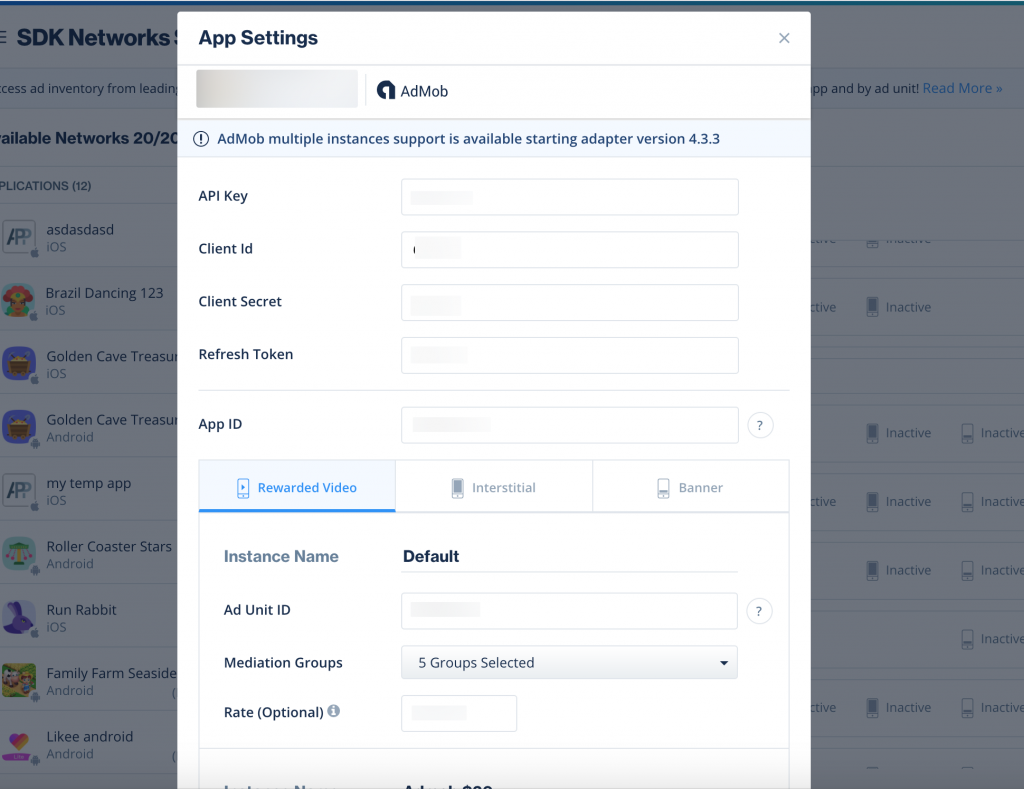
- Verify your integration with the Reporting API; this column will check your integration through the Reporting API and return three possible responses: Verified, Failed and No Response. Double check your integration and the information you entered above; then click ‘Retry‘ until you see ‘Verified’.
- Once you have all of these parameters, log in to your LevelPlay account and go to ‘Monetize‘ ➣ ‘SETUP‘ ➣ ‘SDK Networks‘.
-
Step 4. Add the Admob Adapter to Your Build
As of AdMob SDK 7.69.0+, AdMob are using XCFramework. If you are using CocoaPods for your AdMob integration, make sure you have CocoaPods Version 1.9.0+.
As of V7.42.0 (Adapter version 4.3.3 onwards), AdMob’s SDK requires publishers to add their AdMob App ID to the app’s plist as described here.
Alternatively, you can make this change programmatically
<key>GADApplicationIdentifier</key> <string>[APP_ID]</string>
Replace the “GADApplicationIdentifier” value with the APP ID value you retrieve in step 3.
iOS
LevelPlay SDK supports both Cocoapods and Manual download mechanisms.
Cocoapods
To integrate the AdMob SDK with Cocoapods, enter the following line in your podfile and you’re good to go!
pod 'IronSourceAdMobAdapter','5.4.0.0'
Manual Download
- Download the AdMob Adapter
Add the AdMob Adapter and SDK to your build. You can find the latest AdMob Adapter and SDK here.
As the AdMob Adapter does not contain the AdMob SDK. You need to add the AdMob SDK to your project as well. - Add the AdMob XCframeworks to your Project
- After you download the Adapter and SDK, drop the Adapter and SDK XCframework files into your Xcode Project.
-
- Open Target ➣ Build Settings ➣ Architectures and confirm that your Xcode Project uses Base SDK version 8.0 or greater and that it does not use armv6 architecture.
- Linker Flags:
Add two separate linker flags to Target ➣ Build Settings ➣ Linking ➣ Other Linker Flags:
–ObjC
Step 5. Update Info.plist
As of V7.42.0 (Adapter version 4.3.3 onwards), AdMob’s SDK requires publishers to add their AdMob App ID to the app’s plist as described here.
Alternatively, you can make this change programmatically
<key>GADApplicationIdentifier</key> <string>[APP_ID]</string>
Replace the “GADApplicationIdentifier” value with the APP ID value you retrieve in step 3.
Not doing so results in crashes originated with AdMob’s SDK. For more information please refer to AdMob’s guide.
Step 6. Additional Steps
Child-directed setting – COPPA
Unity LevelPlay mediation lets publishers communicate AdMob Child-directed settings directly to the AdMob network.
This feature is enabled using LevelPlay SDK 6.14.0+, AdMob iOS Adapter 4.3.11+.
Use the following syntax, to set AdMob tagForChildDirectedTreatment with the parameter YES:
[LevelPlay setMetaDataWithKey:@"AdMob_TFCD" value:@"true"];
Use the following syntax, to set AdMob tagForChildDirectedTreatment with the parameter NO:
[LevelPlay setMetaDataWithKey:@"AdMob_TFCD" value:@"false"];
To learn more about Child-directed settings Under AdMob network visit here.
here.
Users under the age of consent – GDPR
Unity LevelPlay mediation lets publishers communicate with AdMob network, a Tag For Users under the Age of Consent in Europe (TFUA) request.
This feature is enabled using LevelPlay SDK 6.14.0+, AdMob iOS Adapter 4.3.11+.
Use the following syntax, to set tagForUnderAgeOfConsent with YES:
[LevelPlay setMetaDataWithKey:@"AdMob_TFUA" value:@"true"];
Use the following syntax, to set tagForUnderAgeOfConsent with NO:
[LevelPlay setMetaDataWithKey:@"AdMob_TFUA" value:@"false"];
To learn more about Child-directed settings Under AdMob network visit here.
here.
Ad Content filtering
Unity LevelPlay mediation lets publishers communicate with AdMob network, maximum ad content rating for all ad requests.
This feature is enabled using LevelPlay SDK 7.12.0+, AdMob iOS Adapter 4.3.28+.
Use the following syntax, to set maxAdContentRating:
[LevelPlay setMetaDataWithKey:@"AdMob_MaxContentRating" value:@"MAX_AD_CONTENT_RATING_G"];
The possible values for this property are based on digital content label classification as defined by Google:
- MAX_AD_CONTENT_RATING_G
- MAX_AD_CONTENT_RATING_PG
- MAX_AD_CONTENT_RATING_T
- MAX_AD_CONTENT_RATING_MA
To learn more about Ad Content Rating property Under AdMob network visit here.
Content URL mapping support
Unity LevelPlay supports Google’s content mapping for apps, and allows you to share URLs using “Google_Content_Mapping” settings. This feature is enabled using LevelPlay SDK 7.7.0+, AdMob Adapter 4.3.51+. Learn more about Google’s content mapping here.
To pass a single-content URL, use the following syntax:
[LevelPlay setMetaDataWithKey:@"Google_Content_Mapping" value:@"https://www.example.com"];To support multiple urls, use the same key and share up to 4 URLs:
[LevelPlay setMetaDataWithKey:@"Google_Content_Mapping" value:@[@"https://www.example1.com",@"https://www.example2.com"];Step 7. Enable Native ads (closed beta)
Resources bundle
The resources bundle contains the Native Banner Custom views for the different banner sizes. Follow these steps to add the resources bundle to your project:
- Click on your project target
- Go to the build phases tab
- Open the Copy Bundle Resources and click on the + icon
- Choose the ISAdMobResources.bundle and click on Add
Verify Your Ad Network Integration
The LevelPlay SDK provides an easy way to verify that your mediation integration was completed successfully. To verify your LevelPlay and additional Ad Networks’ integration, follow this document.
Done!
You are now all set to deliver Admob Ads within your application!
What’s Next?
To leverage additional mediation ad networks, integrate the adapters and follow our integration guides.

